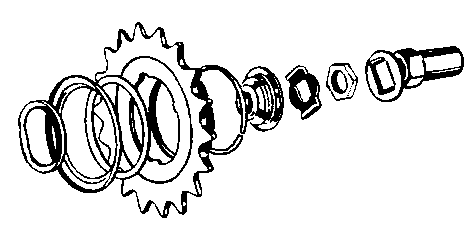


From the left of the diagram : left-hand axle nut, axle locking washer, cone locknut, Axle cone with dustcap, outer dust cap, ball cage with balls, left-hand ball cup.
Old-style threaded ball cup shown. These had a left-hand thread. Newer hubs, since the early 1960s, use a pressed in left-hand ball cup, with a splined attachment to the hub shells. This type of left-hand ball cup can easily be identified by the absence fo wrench flats.

From the left : outer dust cap, sprocket dust cap, sprocket spacing washer, sprocket, circlip, axle cone and dust cap, right-hand cone locking washer, cone locknut, axle locking washer, right-hand axle nut.
![]()
![]()

And here are some of the weeny vital bits you'll find inside:

Clutch sleeve, collar for compensator spring (very weeny!), compensator spring, sliding clutch, axle key, thrust ring, thrust washer, clutch spring, clutch spring cap.
The compensator spring is not generally used on three-speed models.And some more vital bits from right in the middle - you may never get to dismantle these :

Locknut, locking washer, dog ring, low gear key, pinion sleeve, secondary sun pinion, primary sun pinion. The dual sun-pinions are not generally used on three-speed models.
Gear ring and driver (These are common to most models.):


Planet cage:



On the left is the planet cage with all its bits still in. You should be able to remove various bits from here : pawls, pawl pins and hair-like springs that get lost, and are somewhat difficult to put back in. And a selection of planet pinions and pins.
indicator rods - these may be in 2 halves like this one, but most three-speed models use a single piece indicator rod that threads into the axle key.

And lastly, the bare axle with low gear spring - these do vary a lot in appearance, but I'm sure you'll know this bit when you see it! :

![]()
![]()
Last Updated: by Harriet Fell